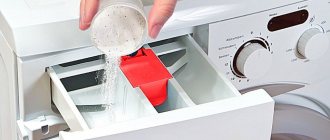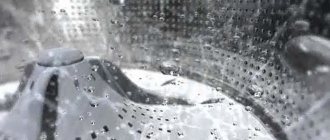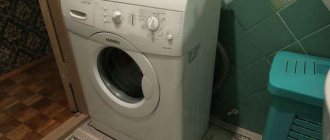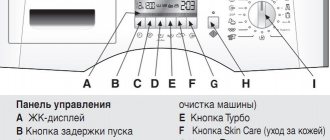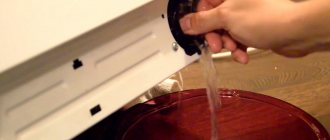Buying a washing machine is only half the battle. After delivering the equipment home, it is necessary to correctly install the machine, remove it from packaging, connect it to communications and remove the transport bolts. The last point is often forgotten, which causes premature failure of the unit that is not covered by warranty. If you start washing without dismantling the transport fasteners, the washing machine will suffer serious mechanical damage. It’s easy to avoid an accident – you just need to act strictly according to the instructions.
What can break?
Removing the shipping bolts is a matter of minutes, but simple haste and inattention can play a bad joke on the owner.
After all, if you forget about the fasteners, you can forever lose the machine you just purchased or get yourself into trouble with the warranty and further operation. This perspective can be explained simply. The bolts used during transportation are designed to secure the movable drum of the washing machine. This prevents it from sagging and rotating during transportation and ensures safe and sound delivery. But starting a cycle with the drum stationary will only do harm:
- convulsive “jumps” around the room;
- uncontrolled vibration;
- loud knocks.
All this is the most harmless thing that will happen in this case with the washing machine. More often the matter ends much worse - the drum is damaged, and the machine itself fails.
It is forbidden to turn on the washing machine with transport bolts precisely because of excessive fixation. The drum clamped with screws does not “hang” on vibration-softening shock absorbers, and all shocks from the accelerated motor go directly to the body. The situation is aggravated by the imbalance of the laundry, which crumples and causes random shocks. The type of drive does not matter - non-functioning dampers will harm both direct-drive machines and belt-driven vehicles.
It’s easy to avoid an unpleasant prospect - just remove all the transport bolts in time. Or check the work of the installers: look at the back panel of the machine and make sure that there are closed or unclosed holes in their place. If you can’t find the grooves for the fasteners, you can look at the instructions and check the data sheet. As a rule, four large screws are used for fixation, the absence of which is easy to notice.
Why are bolts needed for transportation?
Conventional household appliances are transported in original packaging and require additional fastenings. But with a washing machine everything is more complicated. Its design includes many moving parts, the integrity of which is compromised without fixation.
In particular, the tank is not screwed to the body, but is suspended on springs - they ensure the mobility of the tank and its shock absorption during operation. If the tank had been attached differently, the machine would have made a noise no worse than a tractor.
And transport bolts are needed only temporarily - for transporting the unit. Elements are provided in SMA of any brands: “Bosch”, “Indesit”, “Siemens”, “Electrolux”, “Zanussi”, “Atlant” and others. The purpose of the fastening is to hold the tank in which the drum is located motionless, so that this unit does not touch other parts during transportation, such as shock absorbers and others.
What do the bolts look like?
The fasteners have a primitive design of three parts: the screw itself, a rubber ring and a plastic insert. They are installed not only on standard front-facing models, but also on vertical washing machines.
Where are the fasteners located?
To determine the location of the clamps, find out the type of loading of the SMA: vertical or frontal. A regular car with a transparent hatch has only one option for their location: on the rear wall.
There can always be surprises with vertical models, so check your owner's manual to make sure you don't confuse the screws with other fasteners. Usually the manual describes in detail where the transportation bolts are located and the dismantling sequence.
According to the standard, there should be 4 screws. Did you find 2 or 3? Don’t be alarmed, this is normal, it means the manufacturer decided that this quantity is enough.
WHAT HAPPENS IF YOU DO NOT REMOVE THE TRANSPORT BOLTS
Operational characteristics depend not only on components, assembly and installation quality, but proper transportation is also of no small importance. The drum is the most vulnerable part during transportation
It moves inside the machine with virtually no restrictions due to the fact that it is mounted on powerful shock absorbers with a spring configuration. During movement, the drum swings violently, which can damage the inside of the washing machine. To prevent such a situation, transport bolts are used. Transport bolts must be removed before turning on the equipment for the first time, so as not to cause a breakdown of the washing machine. How should household appliances be transported, for what purpose are transport bolts used and how should they be removed? For what purpose are these devices used? Shipping bolts are used to secure the tank and are an integral part during the transportation of household appliances. Most often, they are installed by the manufacturer to prevent damage to household appliances during transportation. The bolts securely secure the tank - when the washing machine is tilted, the internal components will not interact with each other. Shock absorbers, as well as bearings, will remain intact and intact, which is important. They are designed to reduce the vibration of equipment during washing and spinning. How to remove the transport bolts? Do not forget that until the components securing the tank are removed, the washing machine cannot be used. Otherwise, the device will not work properly, which will inevitably lead to breakdown. The service center will refuse warranty repair or replacement of the washing machine if the cause of the malfunction is the transportation bolts. In this case, they do not admit the manufacturer’s fault. Where are the shipping bolts? Manufacturers place them on the back of the washing machine. Most often there are no more than 4 pieces. They look like iron pins. Before you start using the washing machine, you just need to unscrew the bolts. A universal wrench is perfect for this procedure. The size of the bolts varies in the range of 10-14 mm. Some manufacturers provide washing machines with a suitable wrench. If suitable keys are not at hand, the bolts can be unscrewed using pliers. To remove the pins or transport bolts from the washing machine, they need to be turned 45 degrees. After which they are easily pulled out of the case. Almost all manufacturers equip their equipment with round plugs. To close the holes, they are inserted in place of the bolts. Thanks to these plugs, not only a visual effect is created, but also the noise during operation of the washing machine is reduced. Useful tips The transport bolts do not need to be thrown away after removal. Manufacturers recommend saving them for the future - you may have to change your place of residence, and they will be needed during transportation. They are easily inserted into their original place and fix the drum in a stationary position, which will avoid damage during transportation. To remove the decorative plugs, use a knife or nail scissors. To screw in the shipping bolts, neither a key nor pliers are needed. The procedure takes minimal time. If the drum is fixed correctly, there is no need to worry about the integrity of the washing machine during transportation. Conclusion Manufacturers of household appliances have developed many protective functions for their products, and shipping bolts are one of these elements. Thanks to them, the spring suspension system remains safe and sound. You simply unscrew them before starting the washing machine for the first time, and if the need arises for transportation, screw them back into place.
How to connect the Candy washing machine?
Let's analyze the sequential connection of the Kandy washing machine to communications.
To electricity
The socket to which the Candy washing machine will be connected must exactly correspond to the parameters of permissible energy consumption (the necessary data is indicated in the passport of the household appliance). The grounded socket must be connected to the meter via a separate line, with an output to the machine.
Additionally, a residual current device is installed on the power line (the RCD will operate in the event of a short circuit, protecting the household appliance from malfunctions and the house from fire).
In conditions of high humidity, in the bathroom, special waterproof sockets with a lid are used to connect the washing machine to electricity.
To avoid overloads and fires, it is strictly forbidden to connect the washing machine to the electrical network via an extension cord. It is unacceptable to connect several household appliances to one outlet.
To water supply
The Candy washing machine is connected to the central water supply system of the house using a special hose (included with the household appliance) . One end (straight) is intended for connection to a water pipe. The second end (with an L-shaped turn) is connected to the body of the washing machine.
If the hose from the Kandy washing machine kit does not fit in length, it can be replaced by any long hose with a similar fastening, purchased at a plumbing store. The inlet hose is connected to a metal water pipe using the tapping method, using a crimp coupling.
Algorithm of actions:
- The crimp coupling (the part consists of two halves) is fixed to a predetermined place in the water pipe (the coupling is bolted together for strength).
- A hole is drilled through a threaded hole in one of the coupling halves, the diameter of which matches the size of the ball valve inlet.
- Screw the end of the filler valve onto the outlet of the ball valve (the threads are pre-lubricated with sealant or wrapped with plumbing tape).
Connecting a water supply pipe to a metal-plastic pipe is much easier:
- a hole is cut in the pipe into which a fitting (tee) is inserted;
- A ball valve is connected to the fitting, to which the end of the inlet hose of the washing machine is connected.
Before starting the process of connecting the washing machine to the water supply, it is necessary to turn off the water supply to the system (turn the inlet valve), and then open the tap to drain the remaining water from the pipe.
To the sewer
Draining waste water from the Candy washing machine into the sewer system can be organized in several ways.
Direct insertion using a rubber collar
Connection to the sewer through a tee proceeds according to the following algorithm:
- Determine the location of connection to the sewer.
- Cut a piece of sewer pipe and insert a tee (plastic pipe with a branch) in its place.
- Insert the end of the drain pipe into the drain hole on the tee.
To prevent foreign odors from the sewer from penetrating into the washing machine, the corrugation is located at least 50 cm from the floor.
Through siphon
This method of connecting to the sewer can only be implemented if the siphon is equipped with a special connection for the drain hose. The end of the corrugated hose is inserted into the drain pipe and tightened with a clamp.
Drain into a bathtub, sink or toilet
This method is very simple : a special curved “hook” attachment is put on the end of the drain hose, which is thrown over the edge of the bathtub, sink or toilet. This method should not be considered permanent.
The thing is that after each use of the washing machine, the snow-white plumbing fixtures will have to be washed from dirty streaks of waste liquid.
In addition, there is a high risk that the “hook” nozzle will jump off the edge of the bathtub or sink under pressure, and then the entire bathroom will have to be cleaned of dirty stains.
Regardless of the method of connection to the sewer, it is necessary to ensure that the drain hose is not kinked or laid in loops . Experts recommend keeping the bending radius of the corrugation within 50-85 cm (more precise parameters are specified in the washing machine passport).
A special plastic clamp (located on the back panel of the washing machine) will help you fix the desired position of the hose.
The fate of the guarantee
Even running a washing machine once with transport bolts will forever deprive the owner of the warranty provided to the machine. Washing with fasteners not removed is a direct violation of one of the main requirements of the instructions, which leads to automatic termination of the warranty period. Therefore, if the consumer wants to repair third-party breakdowns at the manufacturer’s expense, the consumer will receive a reasoned refusal from the service center.
It will not be possible to hide the fact of a violation of the warranty. If you do not remove the transportation bolts and start the machine, then characteristic damage will remain on the drum, which is easy to notice even with an unprofessional eye. Any further repairs will have to be paid for out-of-pocket.
Monetary losses are also expected when selling a washing machine.
Attention is paid to the condition of the drum first of all, and there is a high probability that after an unsuccessful start, an unpleasant knock and increased vibration will remain. Therefore, it is better to spend time and double-check again than to go to the store for a new machine
It's easy and interesting to communicate here. Join us!
Once there’s nothing right away, then nothing will happen
There won't be any special problems. The main problems have already been felt - noise, bouncing, etc. The transport screws simply fix the drum during transportation, preventing it from moving freely inside. Free movement is necessary just in the washing mode and, especially in the spin mode. After unscrewing the transport screws, the drum is freely hung inside the machine and the springs and shock absorbers dampen vibrations and noise.
QUOTE: A short digression about what will happen if the transport bolts are not removed
We once received an application for warranty repair of an ARDO A-600X washing machine located in a rural area. When asked what was wrong with the machine, the owner answered briefly: it doesn’t work.
When the master arrived at the place, the following picture appeared before his eyes. The machine worked for 8 (.) months with the transport fastenings not removed. To prevent the machine from jumping around the room, the owner replaced the front rubber support legs with a stationary mount made of a metal corner, fixed with dowels to the floor. In addition, the machine is almost completely covered with brickwork on both sides. After the owner dismantled his structures and removed the machine and opened it, the following was discovered: Complete absence of bearings - shaft? rotated? in the landing bushings of the cross. Due to the beating under the weight of the drum, the edge of the pulley facing the tank was completely worn out, simultaneously cutting through the crosspiece, causing the drive belt to jump off and break. Further disassembly revealed even more terrible consequences of the owner’s lack of intelligence - the drum cut off the heating element and the front part of the tank, which simply fell off under the weight of the front counterweight. The belt apparently broke after that. When water poured out of the cut tank onto the floor and the machine stopped completely, the owner decided to call a technician to carry out warranty repairs! According to the master, he had to explain to the client for quite a long time about his violation of the terms of the warranty and the inappropriateness of restoring this machine. .
Manufacturers of large household appliances pay great attention to the safety of their products on the way to the end consumer. High-quality packaging almost completely protects the units from any external damage, provided, of course, that transportation rules are followed.
At the same time, due to the design features, the washing equipment contains devices that prevent damage to internal parts and mechanisms. Regardless of the type, each washing machine on the assembly line is equipped with transport bolts.
Setup and first launch
Before starting the washing machine for the first time, you need to make sure that the body of the household appliance is perfectly level. Minimal misalignment increases the force of vibration, which leads to rapid wear of parts and mechanisms of the internal structure of the washing machine. A building level will help you check how level the housing is installed.
Algorithm of actions:
- The ruler is placed on the lid of the washing machine (alternately in the longitudinal and transverse positions).
- Using a wrench, press out the locknuts on the housing legs.
- By twisting the support heel (clockwise - the leg lengthens, counterclockwise - the leg is shortened) the required position of the washing machine is set.
- Using a wrench, tighten the locknut until it stops, thereby securing the perfectly level position of the housing.
To reduce the level of vibration of the body, special PVC stands are placed under the legs of the washing machine.
The first start of the washing machine proceeds according to the following algorithm:
- washing powder is poured into the main wash compartment;
- set the washing mode for natural fabrics, the water heating temperature is 60°C;
- turn on the device, close the hatch door;
- Press the “Start/Pause” button.
Based on the results of the first test wash, you can evaluate the quality of the washing machine connection and, if necessary, troubleshoot problems in a timely manner.
The first wash is always done “idle”, i.e. without loading the ram. This is necessary in order to clean the inner walls of the drum from factory grease and unpleasant technical smell.
How to transport a washing machine without transport bolts
If you are purchasing a washing machine that has already been used, then special bolts may not be available. In this situation, you will need to remove the top cover of your equipment and fill the entire space with a soft cloth or other material.
For example:
- Rags;
- Foam plastic;
- Foam rubber.
After this, the upper part is returned to its place and secured with the necessary parts. But you need to remember that even with the most careful transportation, the drum will be subject to shocks, as well as damage to the internal walls.
If there are no transport bolts on the washing machine, then during transportation it should be trimmed with material that will prevent mechanical damage.
As for the outer casing, here it is best to use:
- Stretch film
- Corrugated cardboard;
- Soft fabrics.
Transporting a car is a very difficult matter. Vehicles are not designed to transport each type of equipment separately. That is why you need to take a responsible approach to transferring the washing machine. Experts advise that when transporting the washing machine, place it in an upright position and be sure to ensure that the drum and tub are securely fastened. When transporting in a truck, the washing machine must be positioned sideways. If, along with the equipment, there are other larger things in the back, then it is better to install the machine between them to limit its movement. This way you won't have to worry about it moving, jumping or falling.
After the machine has been packaged and is ready for transportation, it must be carefully brought to the transport; problems may also arise with this. It is very difficult to lower the machine from the upper floors in the absence of an elevator; it is advisable to keep it vertically; it should be transported in the same position. If such a descent is not possible, a minimal backward tilt is allowed. Otherwise, there is a risk of the doors opening and, although they are securely fixed, it would not be a bad idea to additionally strengthen them with stretch tape, tape or rope. The drain hose will need to be secured with a tie or tape; it is best to wrap it in soft material.
What happens if the bolts are not removed?
It should be remembered that the Indesit washing machine should under no circumstances be operated with the bolts not removed! If they are not removed, the device will soon fail, and its repair will be very expensive and difficult. Fastenings for transportation reliably fix the internal moving parts to the body so that they fit snugly and not during shaking and sudden movements. During the washing process itself, such fixation will only interfere. During normal operation, the drum rotating inside should not touch the surrounding walls. Otherwise, he will break them and fail himself. Also, the shock absorbers on which it rests will deteriorate due to improper use.
This will happen due to the fact that the springs, which should absorb most of the vibrations produced during washing, will not work properly due to fixation, and all movements of the drum will be transferred to the body of the machine. This can also lead to additional breakdowns of the machine and damage to the plastic elements of the body.
Strong vibrations and shocks during washing and spinning occur because things inside the drum are constantly moving unevenly and the center of gravity is constantly changing. The laundry hits different parts of the drum, and if the fasteners securing it are not removed, these impacts will be transmitted to other parts. Thus, not only the drum, which is not designed to collide with the housing, is at risk of failure, but also the engine, as well as the bearings and systems through which water is collected and drained.
It should be remembered that since the cause of such breakdowns is improper operation of household appliances, the Indesit machine will not be subject to warranty repair. At the same time, replacing and restoring all damaged parts can cost a lot of money.
How to transport a washing machine correctly?
A washing machine is a unit designed for a long period of operation, therefore, for various reasons, during this time it may be necessary to transport the washing machine from one place to another. Minor faults that arise during operation can sometimes be fixed on the spot with your own hands, but in the event of a serious breakdown, transportation to a service center is inevitable. When preparing for transportation, to protect the external parts of the unit, you need to take care of reliable packaging. To prevent damage to internal parts, it is worth installing the saved bolts in their place.
How to transport a washing machine without transport bolts?
It happens that you urgently need to transport your car, but there are no transport fastenings, and there is simply no time to look for them. You can fix the tank without them; for this you will need soft materials with which you will need to surround the tank on all sides until it is completely immobilized. For example, you can use rags or foam rubber. To get to the tank, you need to remove the top cover of the machine. This is easy to do, just unscrew a few screws from the back, pull the cover towards you and lift it up. After the cover is removed, you can begin the above operations to fix the tank.
Call the master
Don’t have time to figure out how to connect a Candy washing machine to communications? Calling a technician to your home will solve this problem .
You can apply to connect your washing machine by phone or through the service center website (the necessary contacts are not difficult to find through Internet search engines).
The amount of payment for services for connecting a washing machine is determined individually (minimum bill - 1300 rubles). The increase in cost may be influenced by: the urgency of completing the order, additional actions for inserting into the sewerage system, water supply system, connecting to the electrical network, the use by the master of parts that the client did not purchase (for example, a ball valve, a tee).
At the end of the work, the master is obliged to run a test wash of the washing machine, after which (if there are no complaints from the client), a full payment can be made.
Where are the shipping bolts located?
The washing machine differs from other devices in that it has a freely moving internal part - a tank with a drum. This is the heaviest part of the unit. It is suspended on powerful springs from the inside of its body, and rests on shock absorbers from below.
When the machine is in one place and not exposed to external factors, its rotating part does not come into contact with other structural elements. However, during transportation of household appliances, it is allowed to tilt them in different planes. In this case, the loose rotating mechanism of the machine can:
- fly off and/or become deformed;
- damage or puncture the tank;
- disrupt electronic control circuits.
To avoid damage as a result of falling or shaking, special fixing elements for the washing machine are used during transportation - transportation bolts. This is the name given to fasteners designed to hold the rotating part of the unit stationary and maintain proper balancing of the drum. In spin mode, this element gains high speed. Its misalignment relative to the axis of rotation leads to strong vibration of the device, increased loads on shock absorbers and bearings and a reduction in their service life.
For all models with front loading and almost all with vertical loading, they are located in the same place - on the rear panel of the case. A rare exception are some top-loading machines: they are equipped with additional protective bolts under the top cover of the unit.
Why does the manufacturer use them?
While a refrigerator, stove or other household appliance can be safely transported in a cardboard box with a foam frame, such protection is not enough for a washing machine. It's all about a special design, which necessarily includes a tank-drum assembly. These elements are in a suspended state, fixed only by a shaft, springs and a pair of dampers. This helps the washer suppress vibration from centrifugal force during high-speed spinning, but makes transportation more difficult.
The problem is that a “suspended” tank, when transported over long distances and on a bad road, will jump like a dummy toy on every bump. The drum will begin to hit the body of the machine, damaging itself and neighboring elements. Shock absorbers will not help in this case.
Shipping bolts are another matter. With their help, the drum is fixed in a stationary position, preventing the tank from touching the body, engine and other components. Thanks to this protection, transporting the washing machine becomes safe.
Shipping bolts are necessary for the safe transportation of the washing machine - they secure the tank, protecting the unit from damage.
The Candy washing machine uses standard bolts. They are long screws and consist of three parts: a metal spiral rod, a rubber gasket and a plastic tip. Only the size of the fasteners varies, the length and diameter of which depends on the model of the washing machine.
The number of clamps used also differs. The number of screws screwed in depends on the brand of the machine, the dimensions of the equipment and the capacity of the drum. Usually 2 to 4 pieces are installed.
What are they and what do they look like?
The details are quite easy to identify at first glance. They are large and easily stand out from the rest of the bolts and parts of the back wall. they look like ordinary threaded bolts with a thick hex head made of plastic and a metal washer. They connect the body and the drum and prevent its deformation.
Shipping bolts are temporary fasteners that are installed on new devices to ensure that the shipping process causes less damage to them. In this case, we are talking about fasteners that secure the washing machine drum, protecting it from deformation and breakdowns that can occur as a result of an impact or fall of the unit during transportation.
The only functional unit of the washing machine that is not rigidly fixed is the tank. It is attached from below to dampers (shock absorbers) and from above to springs. No matter how carefully you transport or carry the washing machine to the installation site, strong shocks cannot be avoided.
Therefore, a structural element that does not have a rigid fastening inside the body will inevitably move in all directions at the slightest shock. This can be avoided by installing shipping bolts (supplied with the appliance).
Installation of fixing parts is carried out at the manufacturer's plant.
The tank-fixing elements look like metal pins of different lengths (depending on the model and manufacturer of the washing machine). Their main task is to keep the tank in a static position during shocks and at the same time not cause damage to the less durable body or elements. Therefore, the transport bolts on the washing machine are supplemented with steel, rubber and plastic washers.
The soft plastic part is designed to come into contact with the housing - it does not damage it under shock loads, and the metal part securely holds the pin in the housing hole and prevents the head of the bolt from pressing through the surface of the housing.
Depending on what kind of washing machine the consumer purchases, from 3 to 6 metal fixing parts can be used when transporting equipment. But usually there are 4 of them.
They are used to ensure reliable and stationary fastening (there is some distance between the tank and the wall of the housing, and this is filled with plastic fasteners).
Usually these details are easily visible on the surface. However, some manufacturers produce non-standard models, on the back wall of which it is difficult to find fixing points.
They are clearly indicated in the instructions for the equipment.
It is necessary to remove the shipping bolts from the washing machine, and only then start using it.
For what? The shock absorbers and springs used to secure the tank inside the body perform the function of damping vibrations and preventing the increase in its swing.
The “stowed position” does not allow springs and shock absorbers to perform their tasks, and therefore equipment that works with pins will soon break down. But the main thing is that it will cause a lot of trouble during use.
If you do not remove the transport bolts, the washing machine will:
- jump (literally) across the floor, moving in all directions;
- make loud noises;
- vibrate very strongly;
- Poor distribution of laundry in the drum.
Metal shipping bolts in a washing machine can also have different head sizes. To remove them you will need a regular wrench (10, 12 or 14) or a special wrench supplied by the manufacturer with the equipment. In addition, pliers are required.
The instructions supplied with the equipment must address the issue of how to remove the transport bolts by selecting a suitable wrench. The extraction process is simple. The metal pin just needs to be unscrewed and removed from the housing. For some models, the pin is removed using pliers. It is required to turn the bolt head a quarter turn with a little effort and remove the rod.
It may happen that the plastic fastener inserts, when removing the metal pins, fall inside the body of the household appliance. They must be carefully removed by slightly tilting the machine. Do not leave plastic parts inside.
They may come in handy if you need to install shipping bolts when transporting equipment to another location. In addition, the presence of plastic parts inside the case can cause noise and damage.
Bolts and other fasteners removed from the washing machine should not be thrown away. They will come in handy when moving. The installation procedure is as easy as the removal procedure. All steps must be done in reverse order.
Adviсe
If you don’t have a building level at hand, your smartphone will help you level the washing machine. Just download the “Call Quick Tools” application, select the “Surface Level” option, and then place the smartphone on the lid of the washing machine.
Based on the readings that appear on the display, you can level the washing machine body as quickly and accurately as possible.
Do not rush to throw away the removed transport bolts . If you move, they will help fix the washing machine tank in the desired position, which minimizes the risk of damage during transportation.
How to transport a washing machine correctly
To transport the washing machine successfully, you must adhere to certain rules:
- clean the washing machine well;
- drain the remaining water;
- remove the hoses;
- remove the plugs by prying the edges with a sharp screwdriver;
- equip the bolts with sealing strips;
- install the mounting bolts.
To properly install the washing machine, it is necessary that the bolts fit exactly into the threaded holes. You will have to tinker with this, since after prolonged use, the threads become clogged. For proper installation, the tank must be slightly rotated by hand.
It is allowed to transport the washing machine on its side with the cuvette pointing down. The best transportation option is considered to be a horizontal position.
If the bolts are lost, you need to order duplicates from the workshop. Manufacturers do not recommend using fasteners from another machine.
From all of the above we can draw a conclusion. The fasteners must be removed for washing. Reinstalled for transport. In the event of a breakdown due to ignoring transportation rules, responsibility falls on the consumer. Warranty service is terminated, expensive repairs are paid by the owner of the product.
Transport bolts are always present in a new washing machine. And if they are not removed before you start using the machine, they can interfere with its normal operation and even ruin your household appliances. In this article we will tell you why these bolts are used, how to find them and what is needed to remove them.
Shipping bolts have a very important function. They are the ones that secure the washing machine tank.
This extremely necessary precaution is needed in order to protect the machine during transportation and lifting to the floor. Thanks to these fixing elements, the internal parts do not come into contact with each other and with the walls when the machine body rolls or tilts during transportation.
This helps to keep not only the washing machine tank intact, but also its other parts. Such as:
- Bearings,
- shock absorbers,
- and other spare parts.
Shock absorbers with bearings provide movable fastening of the tank and reduce its vibration during washing, rinsing and spinning.
How to organize transportation if fastenings are lost?
We have already written about the correct transportation of the washing machine, but it is worth paying special attention to transportation without bolts - over the years of using the machine, they are easy to lose. To maintain the integrity of internal components when packing, loading, moving, descending and ascending to the floor, follow the recommendations of specialists:
- Place the equipment horizontally or on its side (with the powder receiver facing down). Vertical loading is excluded - in this case the tank will become loose, which can lead to internal damage.
Important! The position with the cuvette up is prohibited: water that remains in the detergent receptacle may leak onto the board, causing irreparable damage to the electronic control panel and module.
- Wrap the drum with cloth or foam rubber, you can put pieces of foam plastic.
- Drain the water from the filter and hoses to protect the electrics.
There is no need to go to the trouble of buying screws from other brands. After all, fasteners from Siemens may not fit an Ariston machine. Sometimes, even in the model range of the same brand, bolts are produced in different lengths and diameters and may not fit similar models. Thus, Electrolux produces screws for its machines with a diameter of 6 to 10 mm.
Now you know that transport elements are irreplaceable “guards” of AGR parts, saving them during transportation. Don't lose it and don't forget to remove it before connecting.
How to install
When moving to a new place of residence or if the washing machine breaks down, it may be necessary to transport it. The device must not be transported without replacing the bolts removed before use.
Before installing fasteners, the device should be disconnected from communications and freed from residual water. Then remove the plugs and complete the fastening with 2 sealing washers and a safety pad. The bolts must be inserted into their original places so that their ends fit into the threaded holes on the inside of the housing. The process is completed by carefully tightening the fasteners with a wrench.
What they look like
In appearance, transport bolts are no different from standard fasteners. They look like cylindrical rods with several turns of thread at one end, sharpened to a cone. The second one has a hex head. Each mount assembly is equipped with 2 sealing washers (the metal one is adjacent to the machine body, the plastic/rubber one is adjacent to the tank) and a safety gasket in the form of a cylinder made of plastic. It fits onto the bolt and serves to hold the drum stationary.
The number of shipping fasteners varies, but most often on the back wall of the unit, closer to the side edges, you can see 4 hexagons, which are the heads of the bolts. Their exact number and location can be found in the instructions. After dismantling, it is recommended to keep the safety mounts along with the machine’s passport and warranty card. They may be needed if new transportation is necessary.
What if you run the machine with bolts?
It is prohibited to use the washing machine with the bolts not removed. The fact is that these fasteners fix the drum in a stationary state, which will inevitably lead to disastrous consequences when the engine is turned on. First, the shock absorbers will suffer, then the bearings will take the blow, and then the drum itself and the elements surrounding it will be damaged. The longer this “cycle” lasts, the less chance of “survival” the washer has.
Unfortunately, many people forget about the bolts and start washing with them. In this case, the machine begins to signal a problem as follows:
- during washing, rinsing, and especially during spinning, it begins to vibrate strongly;
- vibration turns into “jumping” around the room;
- The shaking is accompanied by noise and a strong roar.
If the machine, despite the fixed drum, was turned on, you should immediately, forcibly, end the cycle. Afterwards, be sure to call a specialist from the service center to your home and ask to evaluate the condition of the internal parts of the washing machine. The technician will give an expert opinion and, if necessary, carry out the required repairs.
Where are the fasteners located and how to remove them
Some models of washing machines (LG, Ariston) are front-loading. The shipping screws are always located on the rear panel. The fasteners for top-loading machines (Indesit, Zanussi, Whirlpool) are located at the top or rear. The kit includes 4-6 parts. Miniature Kandy machines use 2-3 fasteners.
To remove the screws after transportation, you must perform several steps in a certain sequence:
- Use a wrench to loosen the fastening. It is included in the set of several products: Indesit, Bosch, LG. The bolts are turned in the opposite direction to clockwise rotation, and a small force is applied.
- The screw is pushed in until it stops, approximately 20 mm.
- Then the plastic cylinder and rubber washer are pulled out, while the screws remain in place.
- The bolts are removed.
- The resulting holes are closed with plastic plugs included with the washing machine. These simple details protect the internal area of the product from various debris, dust and moisture.
Good to know! The key can be replaced with pliers. It is impossible to do such a job with a screwdriver.
How to remove bolts from a Candy washing machine
The process of removing the shipping bolts is quite simple. A certain sequence must be followed:
- two bolts are removed from the rear wall;
- the top cover is removed;
- the bolts holding the steel plate are disconnected;
- the foam insert is removed;
- The top cover returns to its place and is fixed with screws.
In some brands of cars, for example, Gorenje or Miele, the fastening function is performed by metal pins. They are removed with pliers.
In Gorenje models, fastening is carried out using metal pins. They can be easily removed with ordinary pliers. To do this, the pin head must be rotated 90 degrees. When the protrusions line up with the slots made on the body, the pins can be easily removed through the hole.
Note! Sometimes the plastic washers slip and fall down. You can get them from the bottom through the holes in the front panel. One is located near the drain pump filter
The second is on the right side, where the drain hose is attached. The machine body may tilt slightly in different directions. The machine vibrates a lot during washing. After completing the cycle, the dropped washers will be near the holes. By pulling the cap and tilting the machine slightly, they can be removed with any sharp object, such as a piece of wire.
One is located near the drain pump filter. The second is on the right side, where the drain hose is attached. The machine body may tilt slightly in different directions. The machine vibrates a lot during washing. After completing the cycle, the dropped washers will be near the holes. By pulling the cap and tilting the machine slightly, they can be removed with any sharp object, such as a piece of wire.
Fasteners must be preserved after removal from the product. They will be useful for subsequent transportation.
How to remove
It is recommended to remove the protective fastenings even before the washing machine is installed in a permanent location and connected to the communications network. When the unit is already placed with the rear panel against the wall (this arrangement is most often preferred), it will be difficult to reach them.
As an additional reminder about the need to remove the shipping bolts from the washing machine, it always comes with plastic plugs designed to cover the vacated holes. They not only perform a decorative function, but also prevent dust and moisture from entering the device, and also muffle the noise of the running engine.
It is recommended to remove parts unnecessary during operation from the device body using any of the following tools:
- a wrench of a suitable size (10-15 mm);
- small universal wrench (with adjustable distance between jaws);
- pliers (if there are no other tools).
The protective fasteners are not screwed in tightly and will not require much time or effort to remove. First, they need to be loosened by turning the key counterclockwise, and then removed manually along with the washers and gasket. Sometimes the instructions come with a special key that makes it most convenient to remove the fasteners.
What happens if you don't remove it?
Before starting operation, the transport bolts must be removed from the washing machine. If they are not removed before the first wash, then during operation the fasteners will prevent the smooth rotation of the drum. The unit will begin to vibrate and make a loud noise. In addition to external manifestations, at this moment the internal parts of the machine can be significantly damaged, even to the point of complete deformation.
Failures that occur due to failure to remove bolts are not covered under warranty. Due to violation of the operating instructions, the service center has the right to refuse free repair to the owner of the damaged device, even with a valid warranty.
What are shipping bolts?
Transportation fastenings are a type of fastening made in the form of threaded pins, at one end of which there is a head for a certain size and type of key. The configuration and size of the product head can be different and depends on the manufacturer, but in most cases it is a hexagon wrench ranging in size from 10 to 17 mm. A pressure washer and soft polymer or plastic bushings are installed on the threaded part of the bolt, which act as dampers and clamps to ensure a tight connection between the parts of the household device.
Functions of the transport fastener
The main functional purpose of the fastener is to protect the parts of the washing machine inside the housing from damage during transportation. The tank and drum of any washing equipment are attached to the body using special springs and shock absorbers. They dampen vibrations that occur during the operation of the machine and have a certain free movement.
If the washing machine is installed and connected correctly, and washing is carried out in compliance with the operating rules, the free play values are within the limits that prevent damage to the internal parts. However, when transporting the unit, sharp impacts and falls are possible, which may result in displacement of the drum, breakage of various fasteners, and disruption of the functions of bearings and seals. In order to prevent internal damage, transport fastenings are used to ensure rigid fixation of the drum in the equipment body.
Functions of the transport fastener
The design of washing machines is such that the tank with a metal drum inside swings freely inside the body. For washing this is an excellent solution, but for transportation it is a disaster. Any shock to a steel machine can damage the drum, especially if it is made of plastic.
To prevent this from happening, the machine is equipped with transport fastenings - bolts with a hex head and two washers. They fix all the insides of the unit and prevent its damage.
The diameter of the bolts is 12–14 mm. In some brands there are fasteners with a diameter of 10 mm. The rubber washer is in direct contact with the body, and the steel washer tightens the fastening. The bolt is also fitted with a special plastic cylinder, which fills the small space between the machine body and the internal parts, rigidly fixing the elements.
Transportation instructions
If there is a need to transport the washing machine to a new location, it must be prepared in advance. To do this, we will perform the following steps.
Disconnect from water and electricity
First, disconnect the power wires from the electrical network and disconnect the hoses for water intake and drainage. Often during transportation, the same mistake is made - they begin to move the “washing machine” without unplugging it from the socket. This may damage the cord and hoses where they are attached.
Pour out the water
Even if the machine has not been washed for a long time, there will still be a small amount of water in the hoses that needs to be drained. After draining the residue, leave the hose holes open to dry.
We fix hoses, wires, hatch
The hoses and power cord must be folded and secured so that they are not damaged or interfere with transportation. The hatch for loading laundry and the powder compartment must be in the closed position. To prevent them from opening when moving, we recommend additionally securing them, for example, with masking tape.
Fixing the tank
An obligatory step is to fix the washing machine drum. If the bolts are not preserved, you can unscrew the top panel and fill the space between the tank with improvised materials (foam rubber, bubble wrap, etc.). This way the drum will remain stationary during transportation.
We pack correctly
The last stage of preparation is packing the washing machine. The ideal option is factory packaging, but you can do without it. Hoses and electrical wires must be wrapped in bubble wrap or any soft cloth. The body should be wrapped with stretch film and covered with foam plastic (corrugated cardboard), after which the packaging should be tightly secured using tape. You can replace the foam with a regular blanket by wrapping it around the body with tape. You also need to install the machine for transportation on something soft (any rags, blanket, etc.).
Transportation methods
During transport, it is important to properly install the washing machine in the vehicle. Three options:
- in a natural upright position;
- on the back wall;
- turn over onto the side wall.
When transporting, it is better to order a truck to place the car in a vertical position, since this option is considered the safest.
If there is not enough space (for example, in a car, in a taxi), the car can be placed in a horizontal position on its side. It is better to choose the side that is closer to the powder compartment; in this case, you must first remove the container for detergents and dry the inside of the water so that moisture does not get into the electronics.
Transportation on the rear panel is also allowed, with the exception of models in which the fill valve design does not allow loading the panel. Otherwise, the heavy weight will simply break the valve.
It is strictly forbidden to transport the device upside down and the front panel. In the first case, this can lead to complete breakdown of the equipment, and in the second, to the breakage of the hatch and rupture of the cuff.




